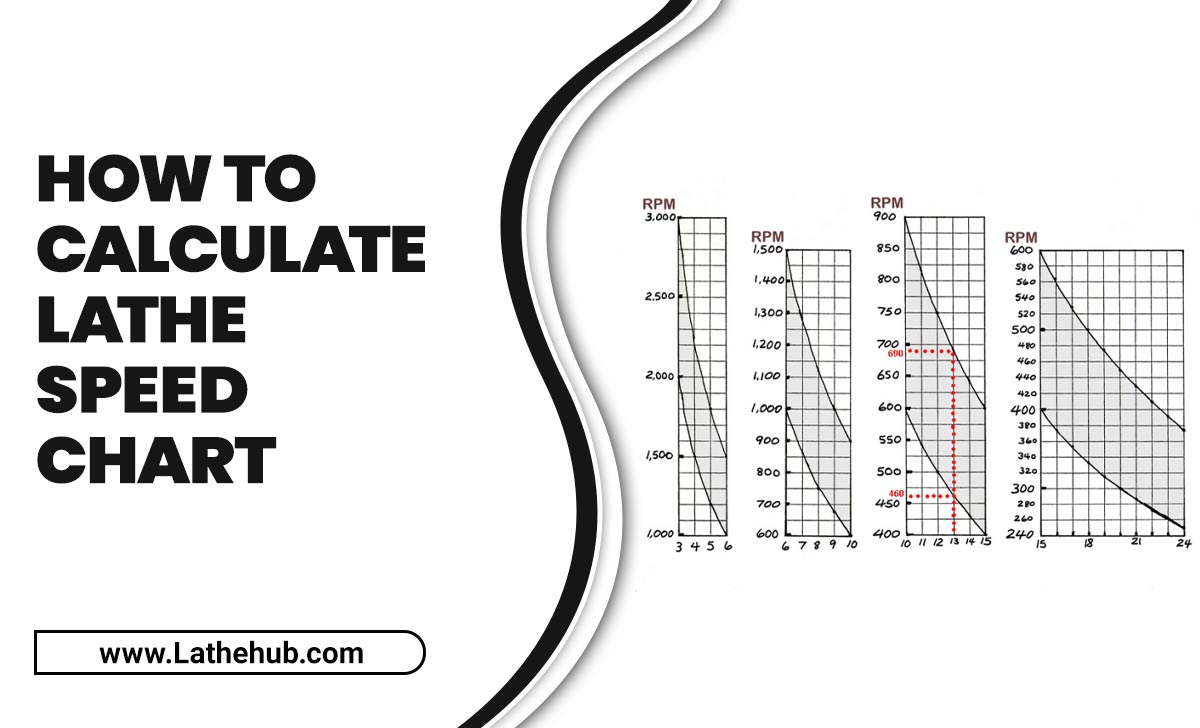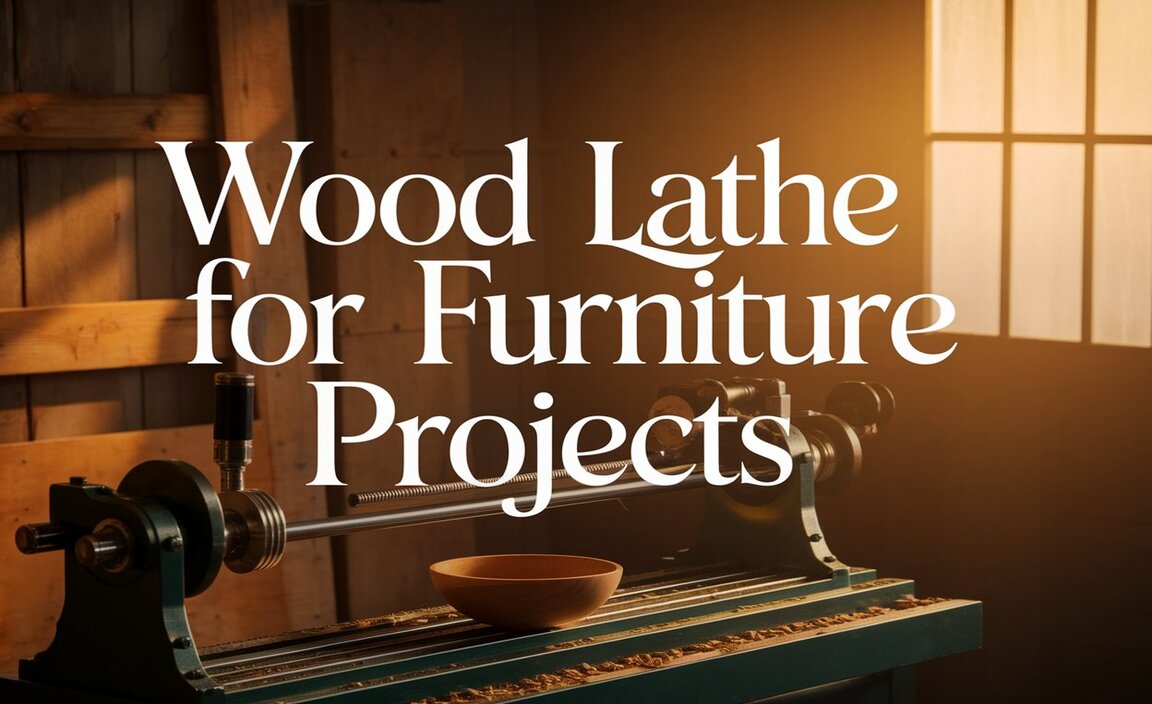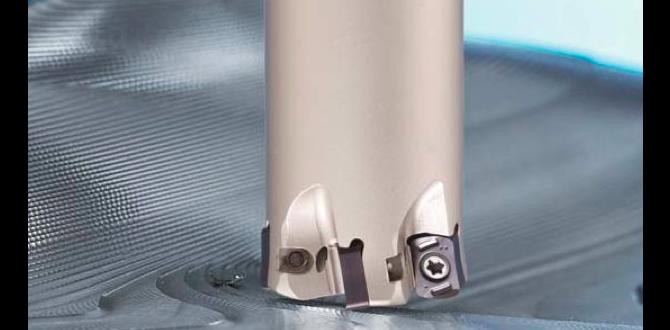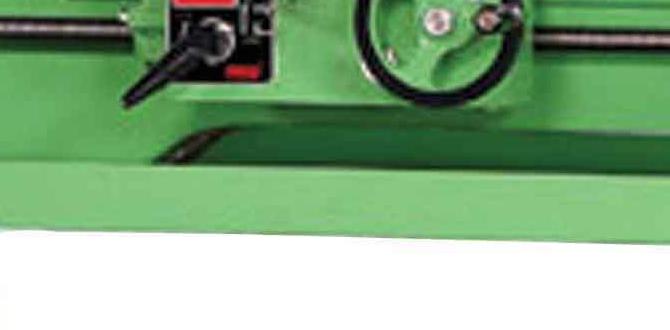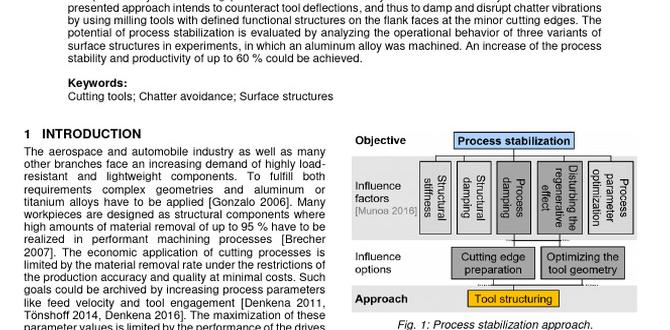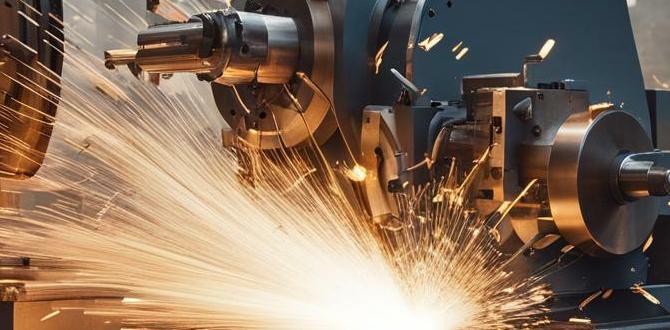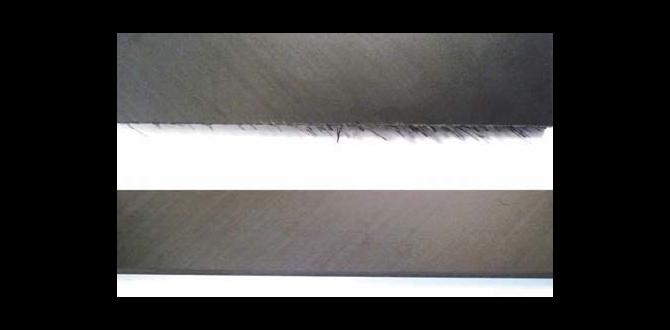A wood lathe vibration isolation mat separates your lathe from the workshop floor, significantly reducing noise and movement for a smoother, safer, and more enjoyable woodworking experience.
Have you ever noticed your wood lathe dancing across the floor when you’re at higher speeds? It’s a common problem that can be more than just annoying. Excessive vibration can lead to rougher finishes on your projects, put extra stress on your lathe’s components, and even pose safety risks. It can make your workshop feel chaotic and less enjoyable. But don’t worry, there’s a simple and effective solution: a wood lathe vibration isolation mat. This guide will walk you through everything you need to know about choosing, installing, and benefiting from one, making your turning sessions much more peaceful and productive.
Why Your Wood Lathe Needs a Vibration Isolation Mat
When a wood lathe spins, especially at higher RPMs or when working with unbalanced stock, it creates forces that can cause the machine to shake. This shaking, or vibration, is a natural consequence of rotating mass. The problem is, these vibrations don’t just stay within the lathe; they travel down its legs and into the floor. From there, they can spread, causing noise that travels through your house or workshop and making the lathe itself less stable.
Think about it: if your lathe is shaking, what happens to the wood you’re trying to shape? It’s harder to get a perfectly smooth surface when the workpiece is constantly jiggling. Your tools might chatter, and trying to make precise cuts becomes a game of chance. Plus, all that shaking can be noisy, disturbing family, neighbors, or even fellow hobbyists in a shared workshop space. It might even make you hesitant to push the lathe to its full potential. This is precisely why a vibration isolation mat is such a game-changer.
The Science of Stability: How Isolation Mats Work
Vibration isolation mats work on a simple principle: interrupting the path of vibration. They are typically made from dense, shock-absorbing materials that can compress and dissipate the energy created by the lathe. When the lathe sits on this mat, the vibration is dampened by the mat’s material before it can reach the floor. This is similar to how the suspension in a car absorbs bumps in the road, providing a smoother ride. These mats act as a buffer, effectively “isolating” the lathe from the surrounding environment.
The effectiveness of a mat depends on its density, thickness, and material composition. Denser materials are better at absorbing and dissipating low-frequency vibrations that often cause that “wobble” feeling. Thicker mats provide more cushioning. Common materials include dense rubber compounds, specialized polymers, or even thick felt layers, often combined to create a robust and effective barrier.
Choosing the Right Wood Lathe Vibration Isolation Mat
Not all mats are created equal, and the best one for you will depend on your lathe, your workshop floor, and your specific needs. Here’s what to consider:
Mat Size and Thickness
The mat needs to be large enough to comfortably accommodate the base of your wood lathe. Ideally, it should extend a few inches beyond the footprint of the lathe for maximum stability and vibration absorption. Measure the dimensions of your lathe’s base or stand before you shop.
Thickness is also crucial. Thinner mats might offer some cushioning, but for significant vibration reduction, you’ll want something substantial. A thickness of 1/2 inch to 1 inch is generally recommended for most wood lathes. Very heavy machines or those prone to extreme vibration might benefit from even thicker mats.
Material Matters
The material of the mat is the most critical factor in its performance. Look for:
- Dense Rubber Compounds: These are excellent for absorbing shock and vibration. Many industrial-grade anti-vibration mats are made from recycled rubber, which is both eco-friendly and highly effective.
- Closed-Cell Foam: Some mats use dense, closed-cell foam. This type of foam resists moisture and is good at absorbing higher-frequency vibrations.
- Layered Materials: The best mats often combine different materials, such as layers of rubber and foam, to address a wider range of vibration frequencies. For instance, a layer of dense rubber on the bottom for heavy vibration and a layer of dense foam on top for finer dampening.
Avoid very soft, porous materials like standard carpet padding or thin foam, as they won’t provide the necessary density to effectively dampen the significant forces generated by a lathe.
Load Capacity and Durability
Ensure the mat is designed to support the weight of your lathe. Most woodworking lathes aren’t excessively heavy, but it’s still a good idea to check specifications if available. A sturdy mat will also resist wear and tear from the lathe’s base and any occasional dropped tools.
A mat made from heavy-duty, industrial-grade materials will offer superior durability and longevity. Think about how much use your lathe gets. If it’s a daily driver, invest in a mat built to last.
Anti-Fatigue Properties (Bonus!)
Many vibration isolation mats also double as anti-fatigue mats. Standing for long periods on a hard workshop floor can be tough on your feet, legs, and back. A good mat will provide a bit of cushioning, making those extended turning sessions much more comfortable. This is a great perk that adds value beyond just vibration reduction.
Cost vs. Value
Wood lathe vibration isolation mats can range from $30 to $150 or more, depending on size, material, and brand. While it might be tempting to go for the cheapest option, remember that you often get what you pay for when it comes to vibration dampening. Investing a little more in a high-quality mat will likely provide better results and last longer, offering better overall value.
Common Types of Wood Lathe Vibration Isolation Mats
When you start shopping, you’ll notice a few standard types of mats commonly used for machinery that generates vibration:
1. Heavy-Duty Rubber Mats
These are often made from recycled tires or dense synthetic rubber. They are typically black, heavy, and feel solid. Their density is excellent for absorbing low-frequency vibrations.
- Pros: Very durable, excellent at dampening heavy vibrations, long-lasting, often moisture-resistant.
- Cons: Can have a rubber smell initially, might be very heavy to move.
2. Foam-Based Anti-Vibration Pads
These might be made from specialized dense foams, sometimes with a textured surface for grip. They are generally lighter than solid rubber mats.
- Pros: Lightweight, can be good for higher-frequency vibrations, often have good anti-fatigue properties.
- Cons: May not be as effective for very heavy, low-frequency vibrations as dense rubber, can be less durable over time.
3. Multi-Layered Composite Mats
These mats combine different materials, like a dense rubber base with a foam or textured rubber top layer. This design aims to provide a broad spectrum of vibration dampening.
- Pros: Excellent all-around performance, often combines the benefits of different materials, can be very effective.
- Cons: Can be more expensive than single-material mats.
For wood lathes, heavy-duty rubber mats and multi-layered composite mats are often the preferred choices due to the potentially significant forces involved, especially when turning longer or unbalanced pieces.
Installation and Setup: Getting Your Mat in Place
Setting up your new vibration isolation mat is straightforward, but a few steps ensure you get the most out of it.
Step 1: Clear Your Workspace
First, move your wood lathe out of the way, if possible. You’ll need clear access to where you want to place the mat and the lathe.
Step 2: Prepare the Floor Surface
The floor beneath the mat should be clean and level. Sweep or vacuum away any dust, debris, or grit. If your floor has significant dips or high spots, consider leveling it if possible. A stable floor is the foundation for effective vibration isolation.
Even a slightly uneven surface can allow the mat to shift or not sit flat, reducing its effectiveness. For a strong foundation, ensure the area is dry and free from oils or spills.
Step 3: Position the Mat
Place the vibration isolation mat in the desired location. Ensure it’s oriented correctly and centered where the lathe will sit. If your mat has a specific top or bottom (check manufacturer instructions), make sure it’s installed according to recommendations.
Step 4: Move the Lathe Onto the Mat
This is often the trickiest part. Carefully position your wood lathe so its legs or base sit squarely on the mat. You might need a second person to help lift or guide the lathe. If your lathe has wheels, ensure they are retracted or locked once the machine is in place on the mat. Some users might find it easier to place the mat and then carefully lower or place the lathe onto it.
Take a moment to check that the lathe is stable and not rocking. The mat should absorb any minor unevenness from the lathe’s base, but if it’s still wobbly, you may need to adjust the lathe’s leveling feet (if it has them) after it’s on the mat.
Step 5: Check for Stability
Once the lathe is in place, give it a gentle push. It should feel much more solid and less prone to sliding or wobbling. The mat should grip both the floor and the lathe’s base, minimizing unwanted movement.
Step 6: Test Run
Start your lathe at a low speed with no wood mounted. Gradually increase the speed and listen for any unusual noises or vibrations transmitted through the floor. You should immediately notice a significant reduction in noise and shaking compared to before. Then, mount a piece of scrap wood and perform a brief test turning to feel the difference in stability confirmed by the mat.
The Benefits of a Quieter, More Stable Workshop
Implementing a wood lathe vibration isolation mat brings a cascade of positive changes to your workshop and your woodworking experience:
Reduced Noise Levels
This is often the most immediate and appreciated benefit. The mat absorbs the vibrations that would otherwise travel into your floor and through your building, significantly cutting down on the audible noise generated by the lathe. This means less disturbance for anyone else in or around your home, and a more pleasant working environment for you.
Improved Workpiece Finish
A stable lathe is crucial for achieving a smooth finish on your turned projects. When the lathe shakes, it’s harder for your tools to make clean cuts, often leading to tool marks and an uneven surface that requires more sanding. With a stable base provided by the isolation mat, your tools can engage the wood more consistently, resulting in cleaner cuts and a better finish right off the tool.
Enhanced Safety
A lathe that vibrates excessively can be a safety hazard. It can move unexpectedly, or the instability can make it harder to control your tools. Reducing vibration makes the lathe more predictable and stable, helping to prevent accidents and providing a more secure platform for your work. The U.S. Occupational Safety and Health Administration (OSHA) emphasizes the importance of stable and well-maintained machinery for safety, and a vibration mat contributes to this by enhancing the machine’s stability.
Increased Longevity of Lathe Components
Constant vibration can put unnecessary stress on the bearings, motor, and other moving parts of your lathe. By absorbing these vibrations, an isolation mat can help reduce wear and tear on these components, potentially extending the lifespan of your machine.
More Comfortable Working Environment
Beyond the direct impact on the lathe, a vibration-dampening mat contributes to a more comfortable workshop overall. Less shaking means less jarring transmitted through the floor and potentially through your feet if you’re standing nearby. This can make long woodworking sessions much less fatiguing.
Better Tool Control
When your lathe is rock-solid, you have better control over your tools. There’s less accidental movement, allowing for more precise cuts and detail work. This can be especially important for beginners learning to master their tools and for experienced woodturners aiming for intricate designs.
Maintaining Your Vibration Isolation Mat
Your vibration isolation mat is a durable piece of equipment, but a little care will ensure it performs optimally for years to come.
- Regular Cleaning: Periodically sweep or vacuum the mat to remove dust and debris. If it gets greasy or sticky, a damp cloth with a mild soap solution should suffice. Avoid harsh solvents that could degrade the material.
- Inspect for Damage: Occasionally check the mat for any signs of cracking, tearing, or excessive wear. If it becomes significantly damaged, it might be time to replace it.
- Check Lathe Placement: Ensure the lathe remains properly centered on the mat. Shifting can reduce the mat’s effectiveness and potentially lead to uneven wear.
- Avoid Heavy Loads or Sharp Objects: While durable, avoid dropping heavy tools directly onto the mat or dragging sharp objects across its surface, which can cause cuts or punctures.
Troubleshooting Common Lathe Vibration Issues
Even with a mat, you might encounter some vibration. Here’s how to address it:
My Lathe Still Seems to Vibrate a Lot
- Check Lathe Base: Ensure the lathe’s legs or mounting points are making full, even contact with the mat. If your lathe has leveling feet, adjust them while it’s on the mat to ensure maximum stability.
- Mat Material/Thickness: Is the mat dense enough and thick enough for your lathe? A lightweight foam pad might not be sufficient for a heavier lathe or one that vibrates excessively. Consider a denser, thicker rubber mat.
- Workshop Floor: Is the floor itself very flexible, like an upper story of a house? While the mat helps, extreme floor flex can still transmit some vibration. Adding rigidity to the floor (if possible) or using an extra-thick mat could be options.
The Mat Slips on the Floor
- Clean Both Surfaces: Ensure both the underside of the mat and the floor are perfectly clean and dry. Any dust, oil, or moisture can reduce friction.
- Lathe Weight: Is there enough weight on the mat? If your lathe is very light, it might shift. Ensure the lathe is positioned so its heaviest parts are over the mat.
- Mat Type: Some rubber compounds have better grip than others. If slippage is a persistent issue, you may need a mat with a different tread pattern or a stickier rubber compound.
My Lathe is Too Heavy to Move Onto the Mat
In this case, you might need to assemble the lathe directly onto the mat, or build a sturdy platform that you can then place on the mat and secure the lathe to. For extremely heavy industrial lathes, machinery mounting pads are specifically designed for this purpose. For most wood lathes, this isn’t typically an issue.
DIY vs. Commercial Mats
While commercial isolation mats are readily available and designed for this purpose, some ambitious DIYers consider making their own. Common DIY approaches involve using thick layers of dense industrial rubber matting, multiple layers of dense felt, or even specialized vibration-damping materials.
However, it’s important to note that achieving the same level of performance and consistency as a professionally manufactured mat can be challenging. Commercial mats are engineered with specific densities and material compositions to provide optimal vibration dampening across a range of frequencies. While a DIY solution might offer some improvement, a well-chosen commercial mat is often more cost-effective and provides superior, reliable results for the average woodworker.
For instance, you can find excellent options made from recycled rubber. Check resources like the U.S. Department of Labor’s guidance on machine guarding and stability, which, while not directly about mats, underscores the OSHA commitment to safe and stable machinery operations. For materials, look at recommendations from industrial supply companies or even some construction material guides for understanding dense rubber compounds.
Frequently Asked Questions (FAQs)
Q1: How thick should a wood lathe vibration isolation mat be?
For most wood lathes, a mat between 1/2 inch and 1 inch thick is ideal. Thicker mats offer more substantial dampening, especially for larger or more vibration-prone lathes.
Q2: Can I just use a piece of old carpet?
No, an old carpet or standard carpet padding is generally not dense enough to significantly reduce lathe vibrations. You need a material with high mass and shock-absorbing properties, like dense rubber or specialized foam composites.
Q3: Will a vibration mat eliminate all noise?
It will significantly reduce noise by dampening vibrations, but it won’t eliminate all sound. Some operational noise from the motor or from the cutting action on wood will still be present. However, the jarring thumps and structural noise will be greatly minimized.
Q4: How do I know what size mat to buy?
Measure the footprint of your lathe’s base or stand. The mat should be large enough to cover this area with a few inches of overhang on all sides for maximum support and stability.

